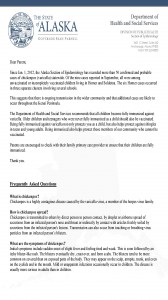 Department of Health and Social Services
Department of Health and Social Services
DIVISION OF PUBLIC HEALTH
Section of Epidemiology
3601 C Street, Suite 540
Anchorage, Alaska 99503
Main: 907.269.8000
Dear Parent,
Since Jan. 1, 2012, the Alaska Section of Epidemiology has recorded more than 50 confirmed and probable cases of chickenpox (varicella) statewide. Of the nine cases reported in September, all were among unvaccinated or incompletely vaccinated children living in Homer and Soldotna. The six Homer cases occurred in three separate clusters involving several schools.
This suggests that there is ongoing transmission in the wider community and that additional cases are likely to occur throughout the Kenai Peninsula.
The Department of Health and Social Services recommends that all children become fully immunized against varicella. Older children and teenagers who were never fully immunized as a child should also be vaccinated. Being fully immunized against varicella not only protects you as a child, but also helps protect against shingles in teens and young adults. Being immunized also helps protect those members of our community who cannot be vaccinated.
Parents are encouraged to check with their family primary care provider to ensure that their children are fully immunized.
Thank you.
Frequently Asked Questions
What is chickenpox?
Chickenpox is a highly contagious disease caused by the varicella virus, a member of the herpes virus family.
How is chickenpox spread?
Chickenpox is transmitted to others by direct person to person contact, by droplet or airborne spread of secretions from an infected person’s nose and throat or indirectly by contact with articles freshly soiled by secretions from the infected person’s lesions. Transmission can also occur from touching or breathing virus particles from an infected person’s blisters.
What are the symptoms of chickenpox?
Initial symptoms include sudden onset of slight fever and feeling tired and weak. This is soon followed by an itchy blister-like rash. The blisters eventually dry, crust over, and form scabs. The blisters tend to be more common on covered than on exposed parts of the body. They may appear on the scalp, armpits, trunk, and even on the eyelids and in the mouth. Mild or unapparent infections occasionally occur in children. The disease is usually more serious in adults than in children.
How soon do symptoms appear?
Symptoms commonly appear between 10-21 days (usually ~14-16 days) after exposure to someone with
chickenpox or shingles (herpes zoster).
When and for how long is a person able to spread chickenpox?
A person is most able to transmit chickenpox from 1-2 days before the onset of rash until all lesions have crusted. People who are immune compromised may be contagious for a longer period of time.
Does past infection with chickenpox make a person immune?
Chickenpox generally results in lifelong immunity. However, the virus can remain hidden and recur years later as shingles in a proportion of adults and even in older children.
What are the complications associated with chickenpox?
Newborn children (less than one month old) whose mothers are not immune and patients with leukemia may suffer severe, prolonged or fatal chickenpox. Immune compromised patients, including those on immunosuppressive drugs, may have an increased risk of developing a severe form of chickenpox or shingles. Reye’s Syndrome has been a potentially serious complication associated with clinical chickenpox involving those children who have been treated with aspirin. Aspirin or aspirin-containing products should never be given to a child with chickenpox.
The CDC has more information about chickenpox complications: http://www.cdc.gov/chickenpox/about/complications.html
Is there a vaccine for chickenpox?
Yes. The chickenpox vaccine is recommended as a two-dose series. The first dose is given between 12-15 months and the second (booster) dose typically given between 4-6 years. The state of Alaska requires two doses of vaccine for entry into grades K-6. See http://www.epi.alaska.gov/bulletins/docs/b2012_06.pdf .
What can a person or community do to prevent the spread of chickenpox?
The best method to prevent further spread of chickenpox is for people infected with the disease to remain home and avoid exposing others who are susceptible. They should remain home until one week after the skin eruption began or until the lesions become dry and crusted. Pay particular attention to avoiding unnecessary exposure of non-immune newborns and immune compromised people to chickenpox.
I have heard about “chickenpox parties” to give everyone the disease so they have natural immunity. Is this a good idea?
“Chickenpox parties” were a common practice in previous generations. Public health experts strongly recommend against this practice now that there is effective vaccine available and much better knowledge about potential serious complications of chickenpox. For more information about risks, we recommend this site: http://www.immunizationinfo.org/issues/exposure-parties/chickenpox-parties
Where can I go for more information?
The CDC has an excellent website for the general public: http://www.cdc.gov/chickenpox/index.html . You can also refer to http://www.cdc.gov/vaccines/pubs/pinkbook/downloads/varicella.pdf (“The Pink Book”) for more detailed scientific information for public health personnel.
eptember 2012 Letter to Parents, and more at KPBSD Health Services links
